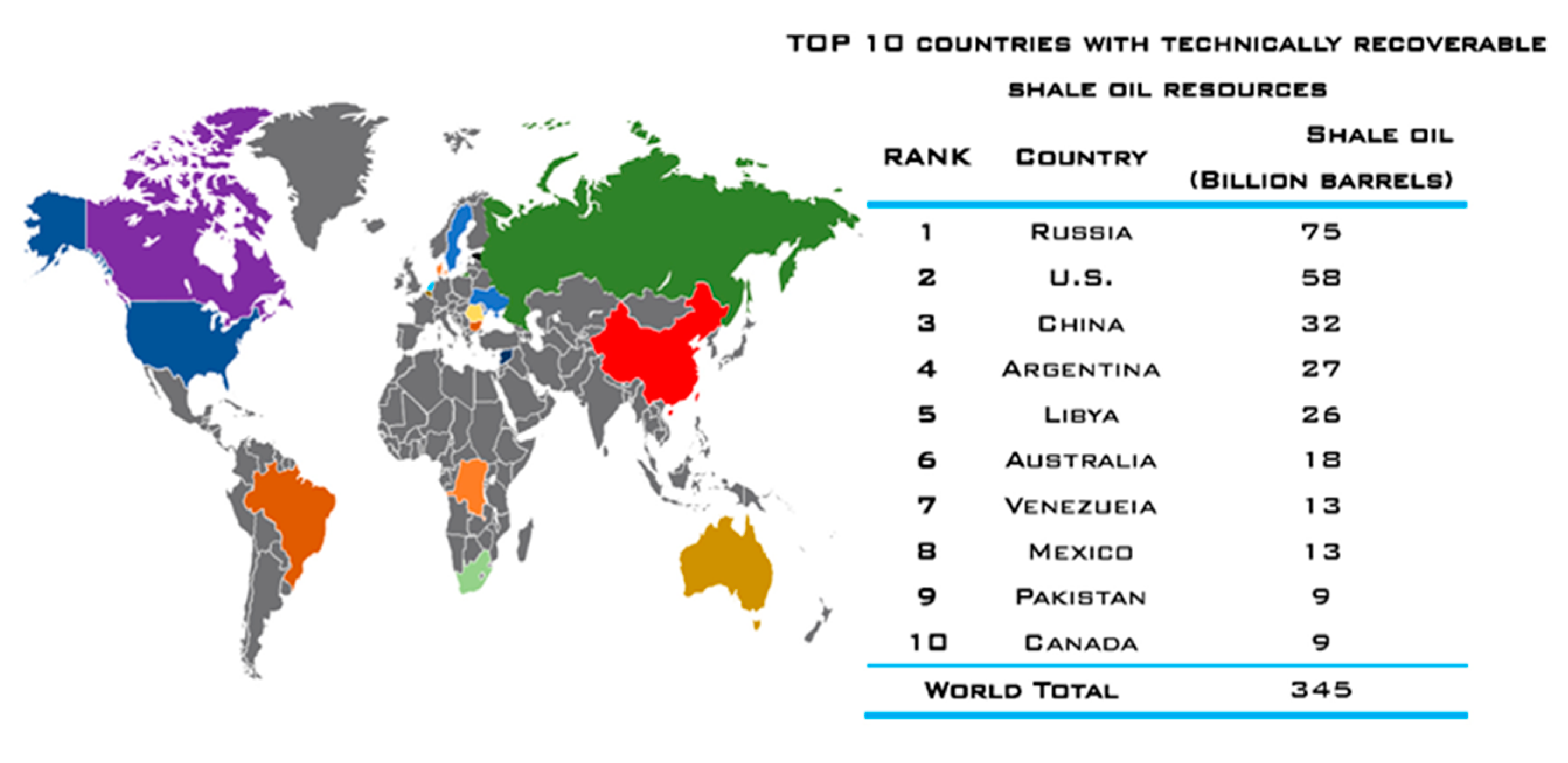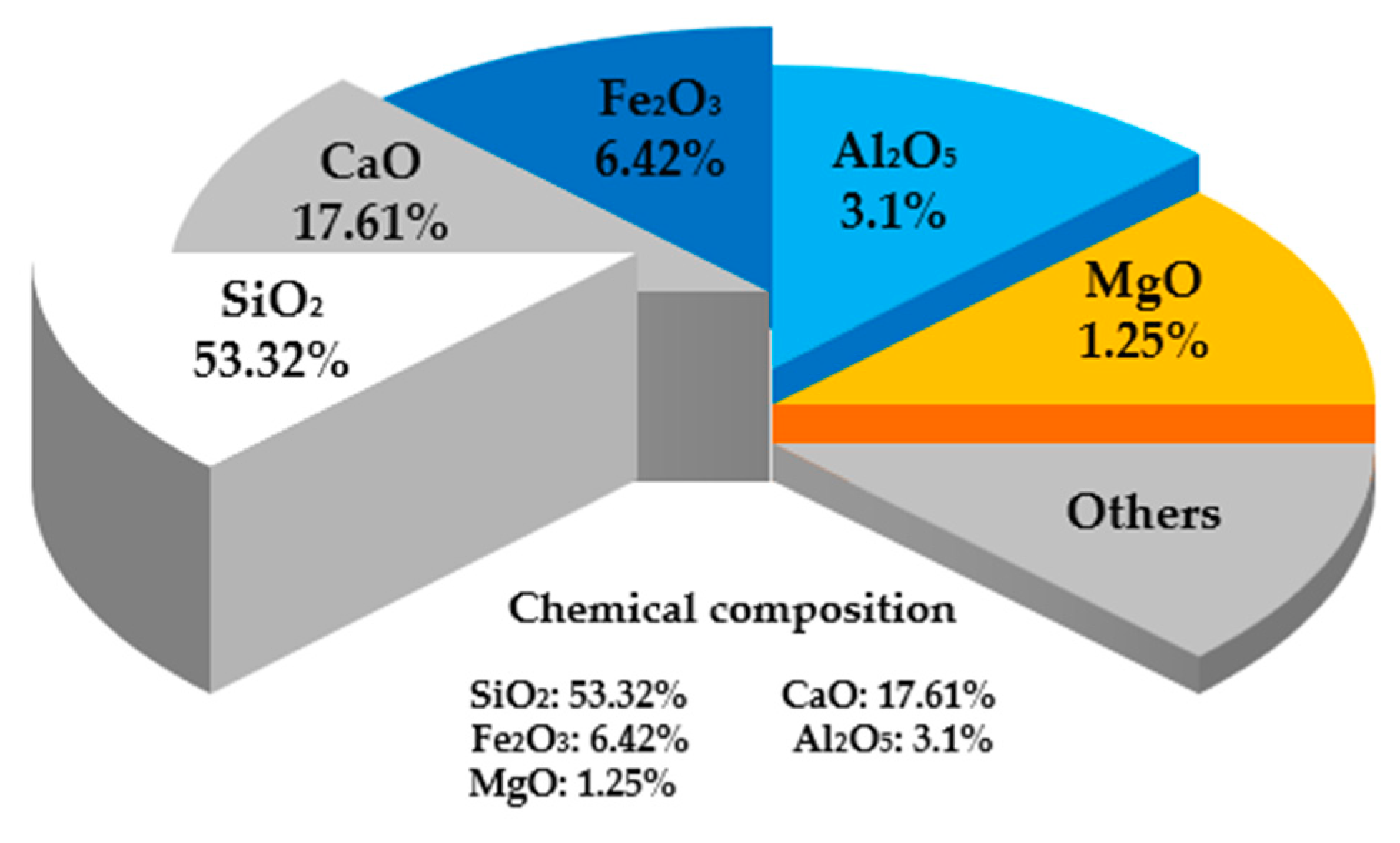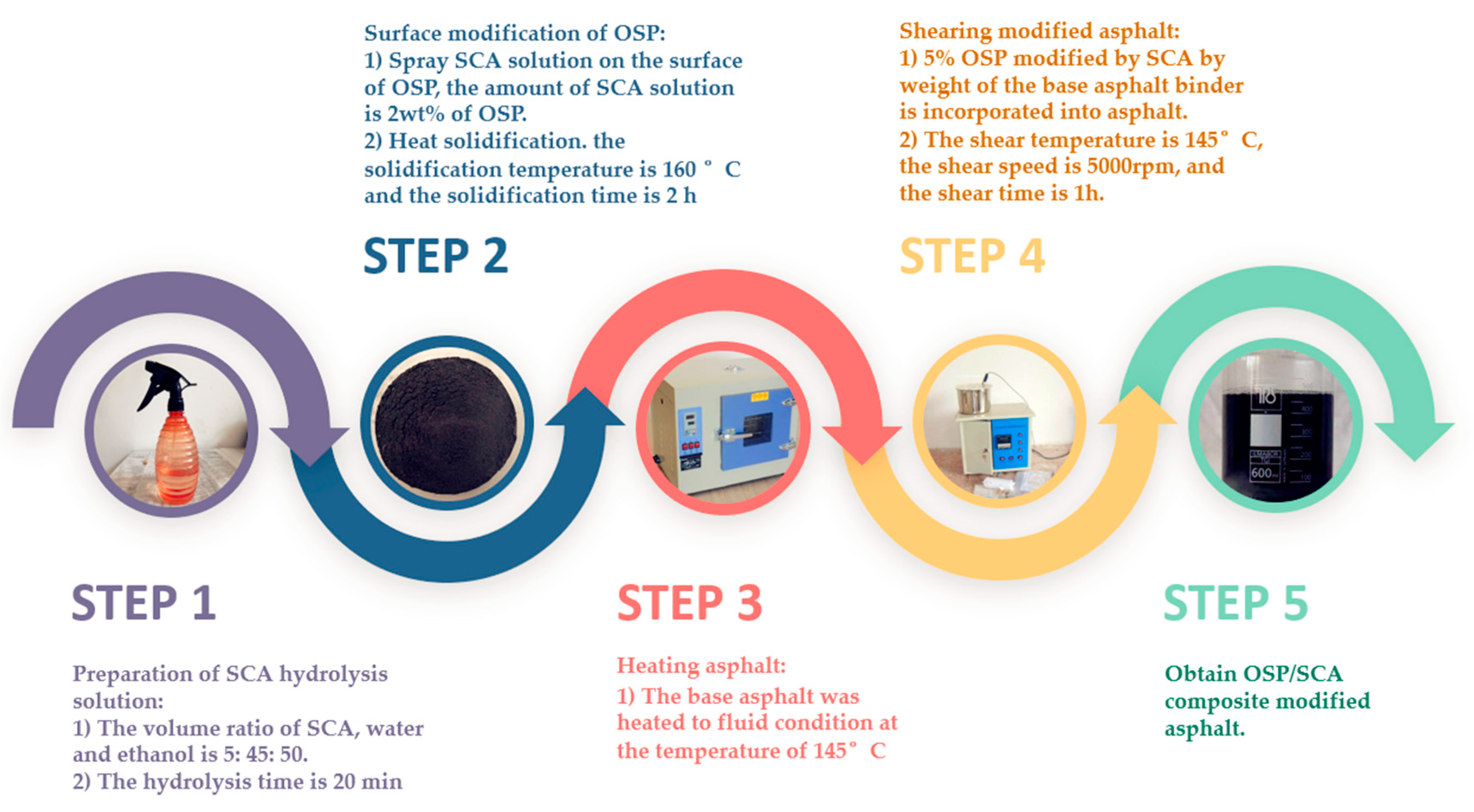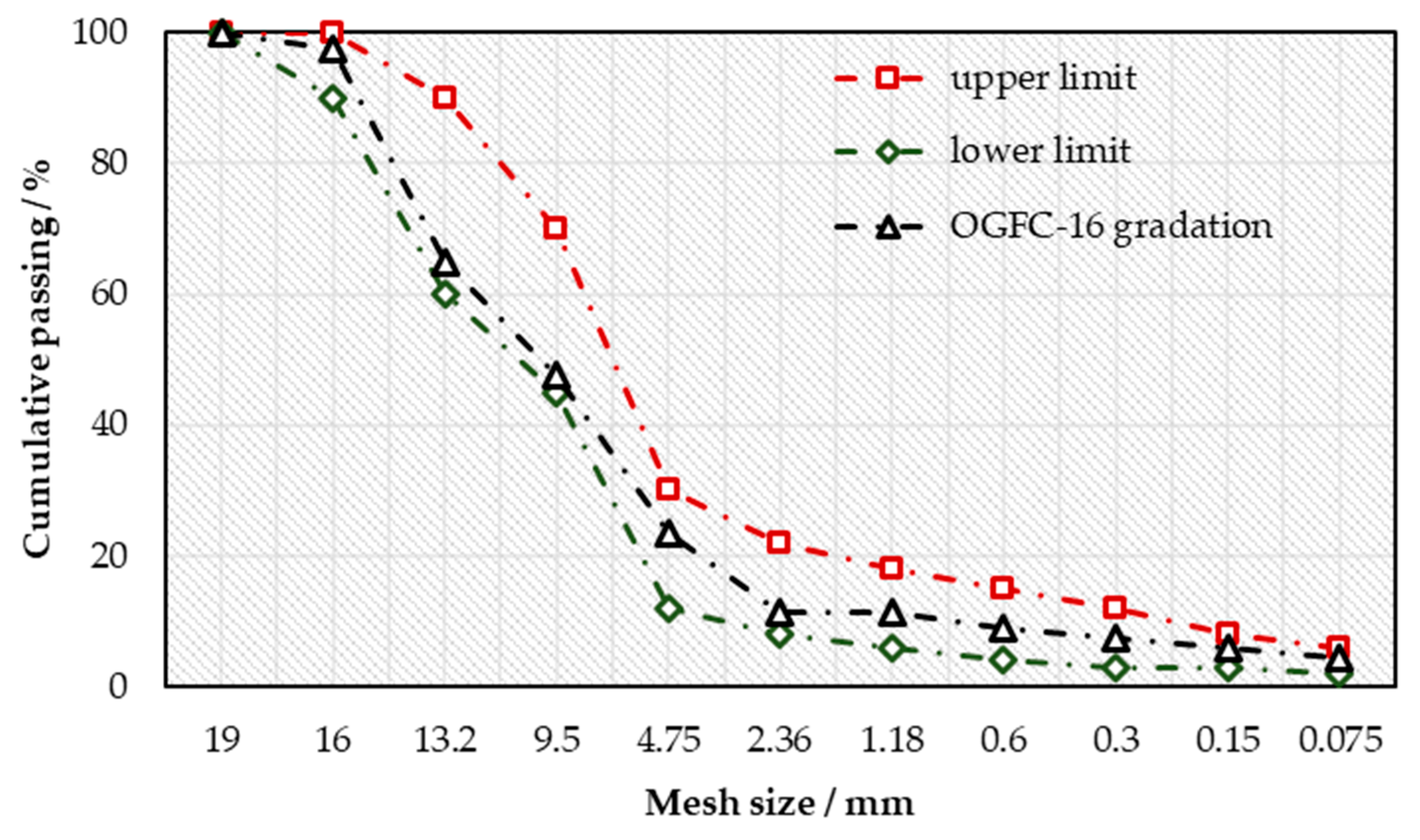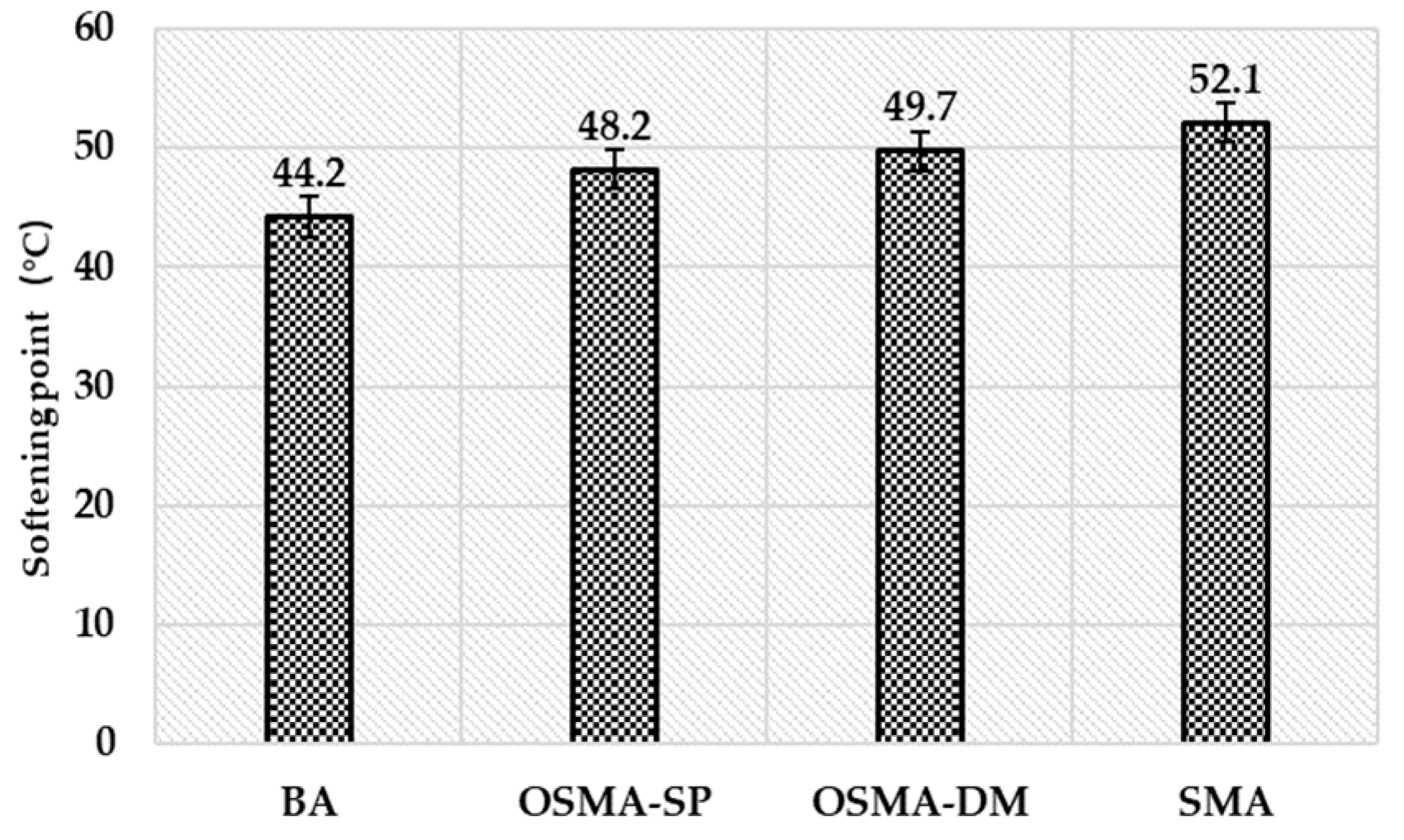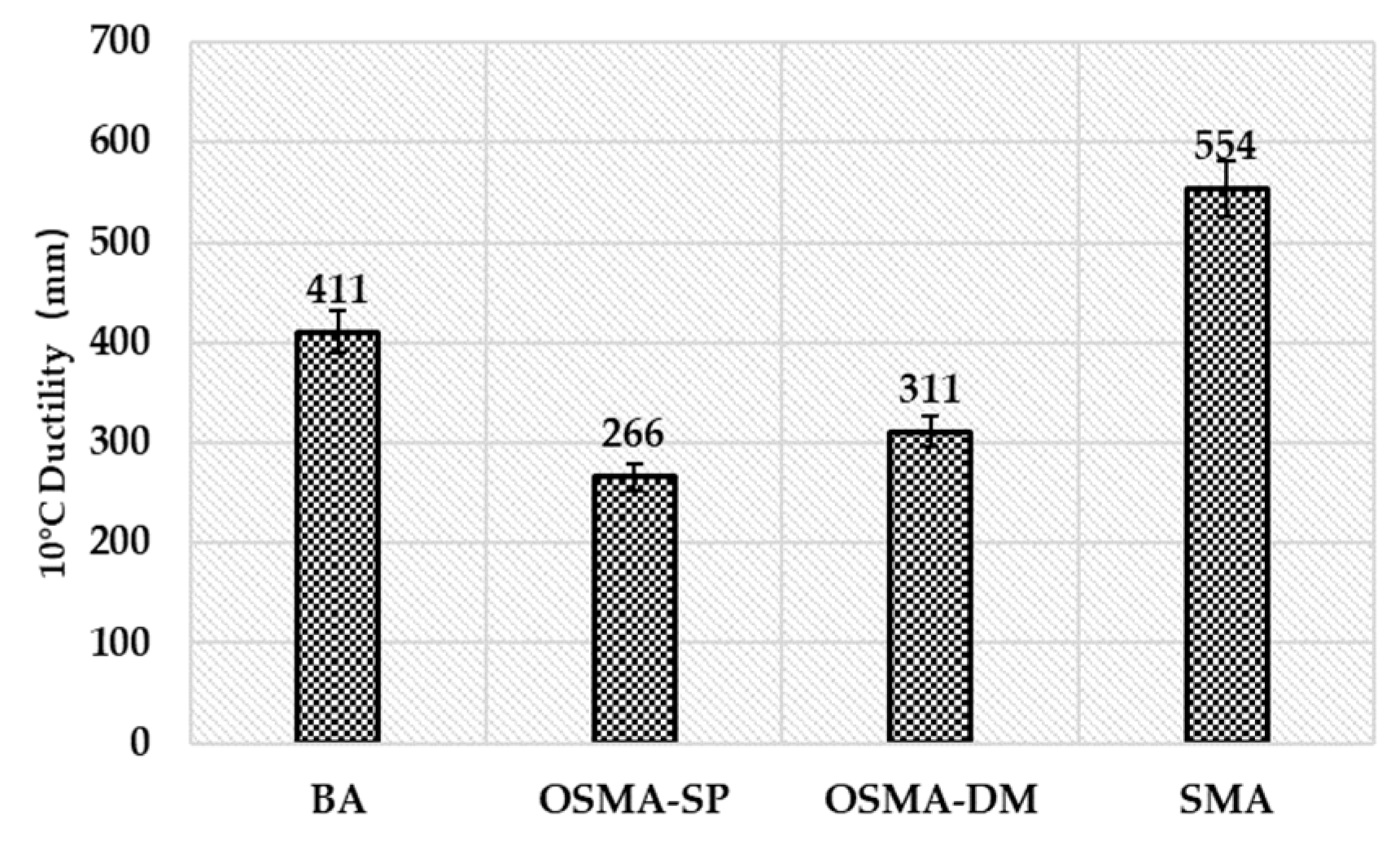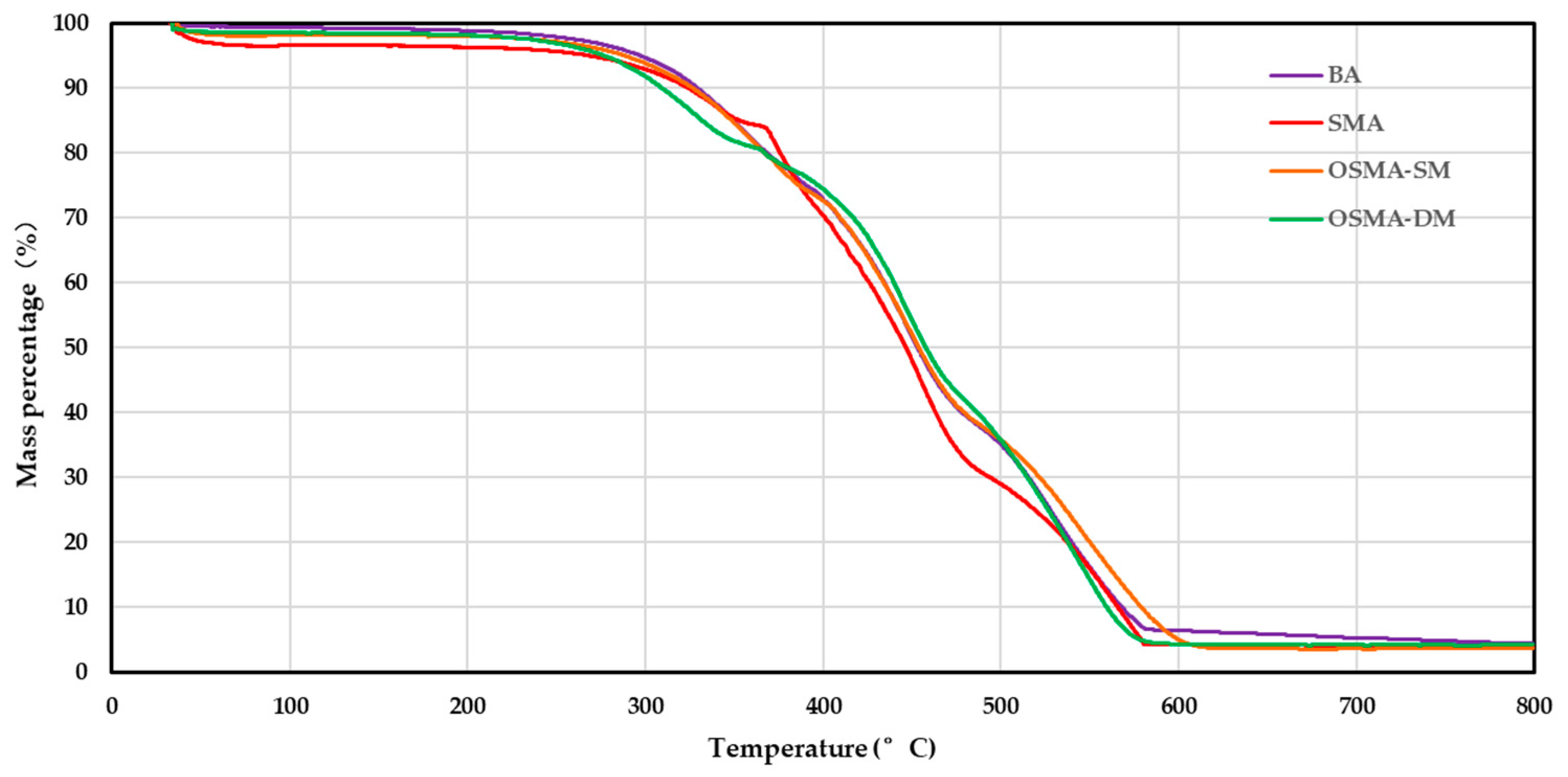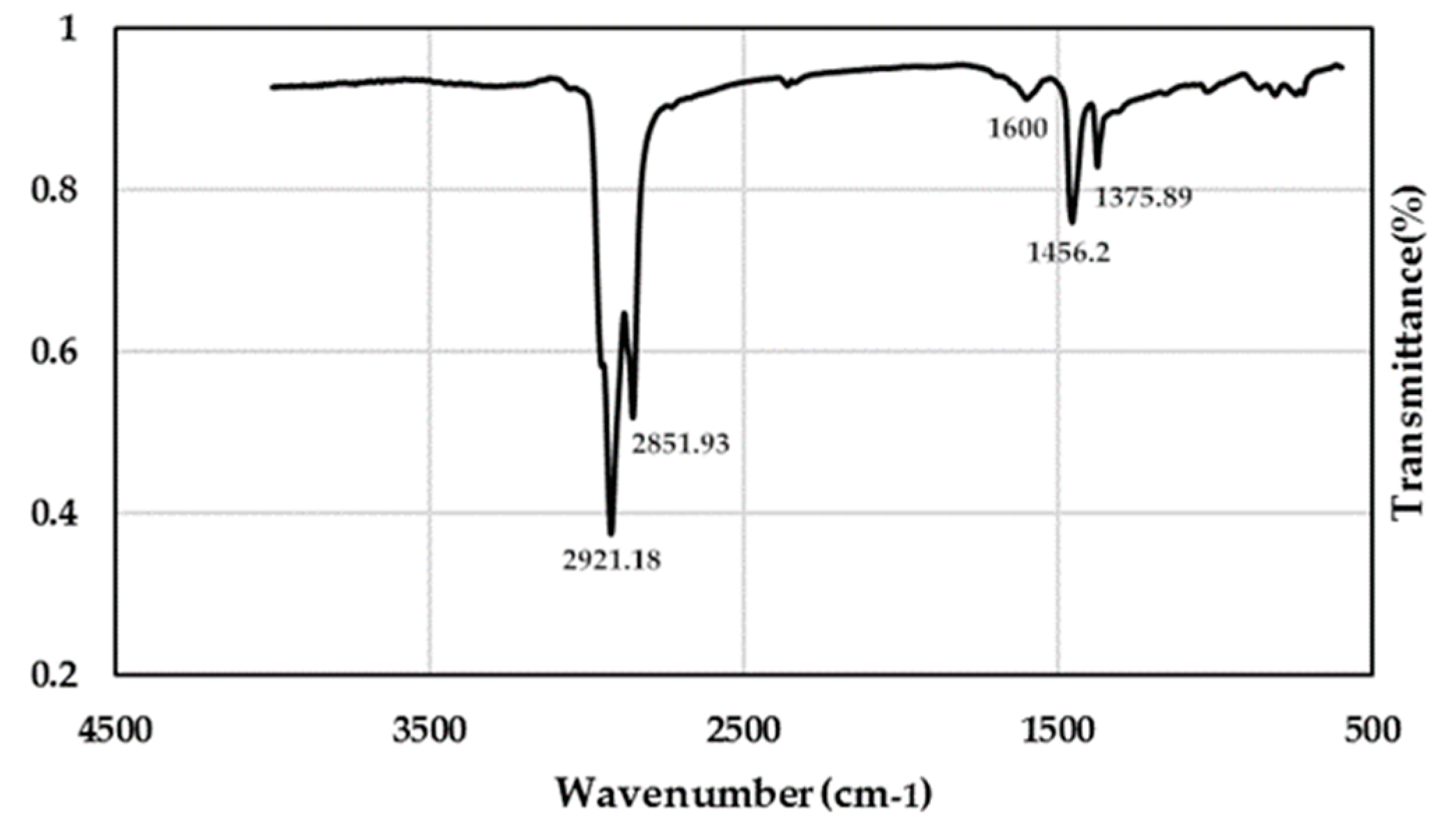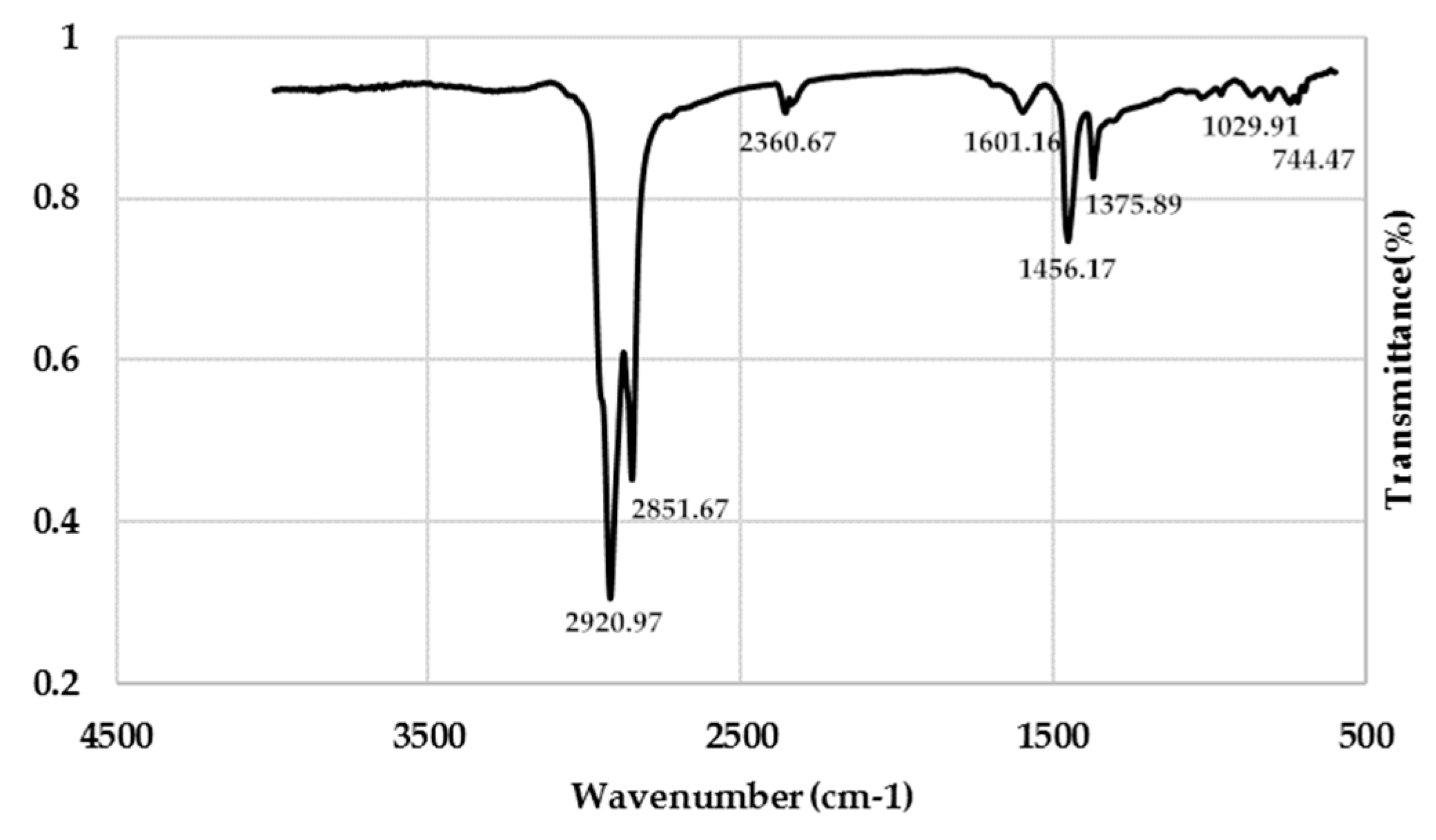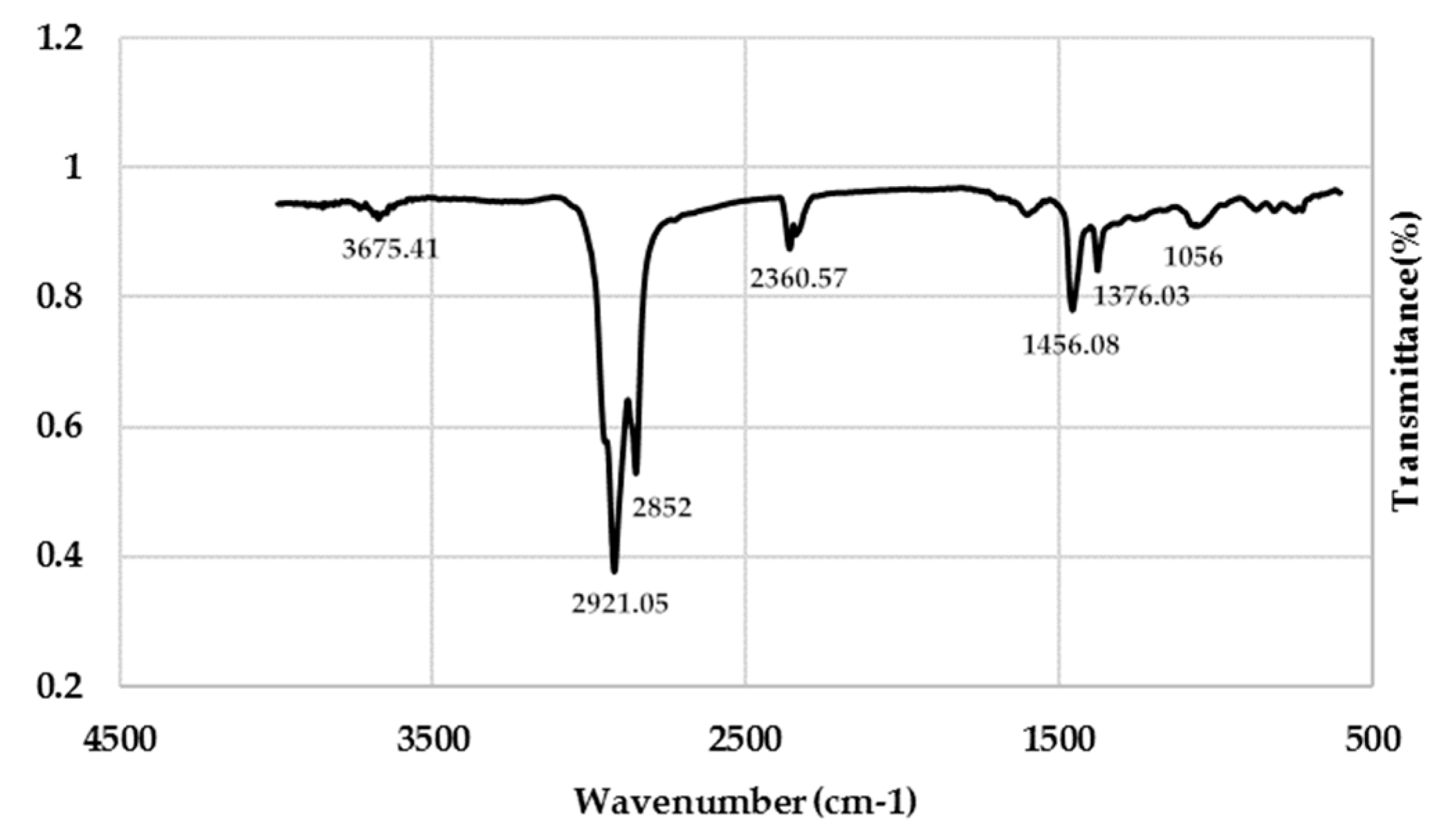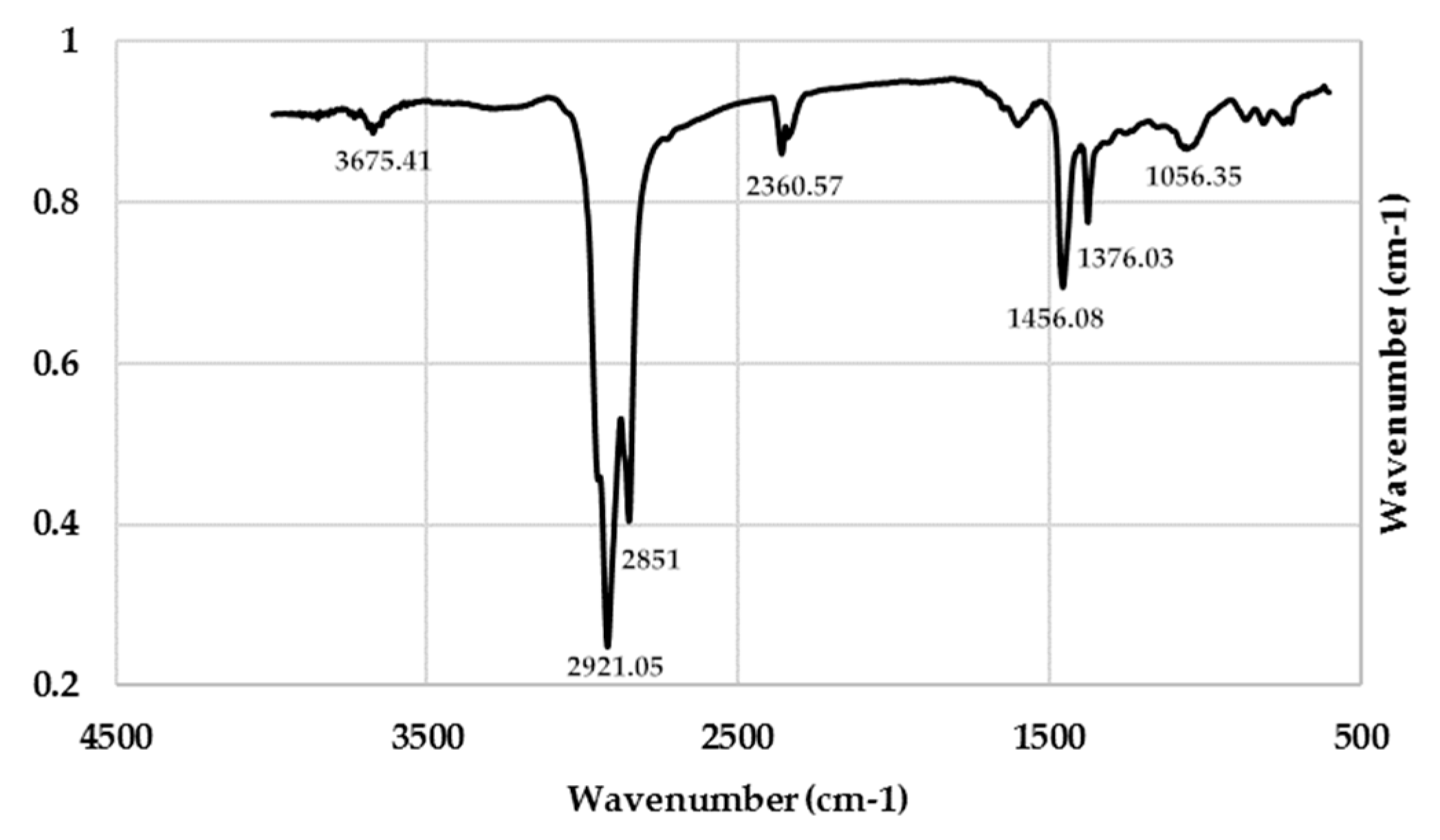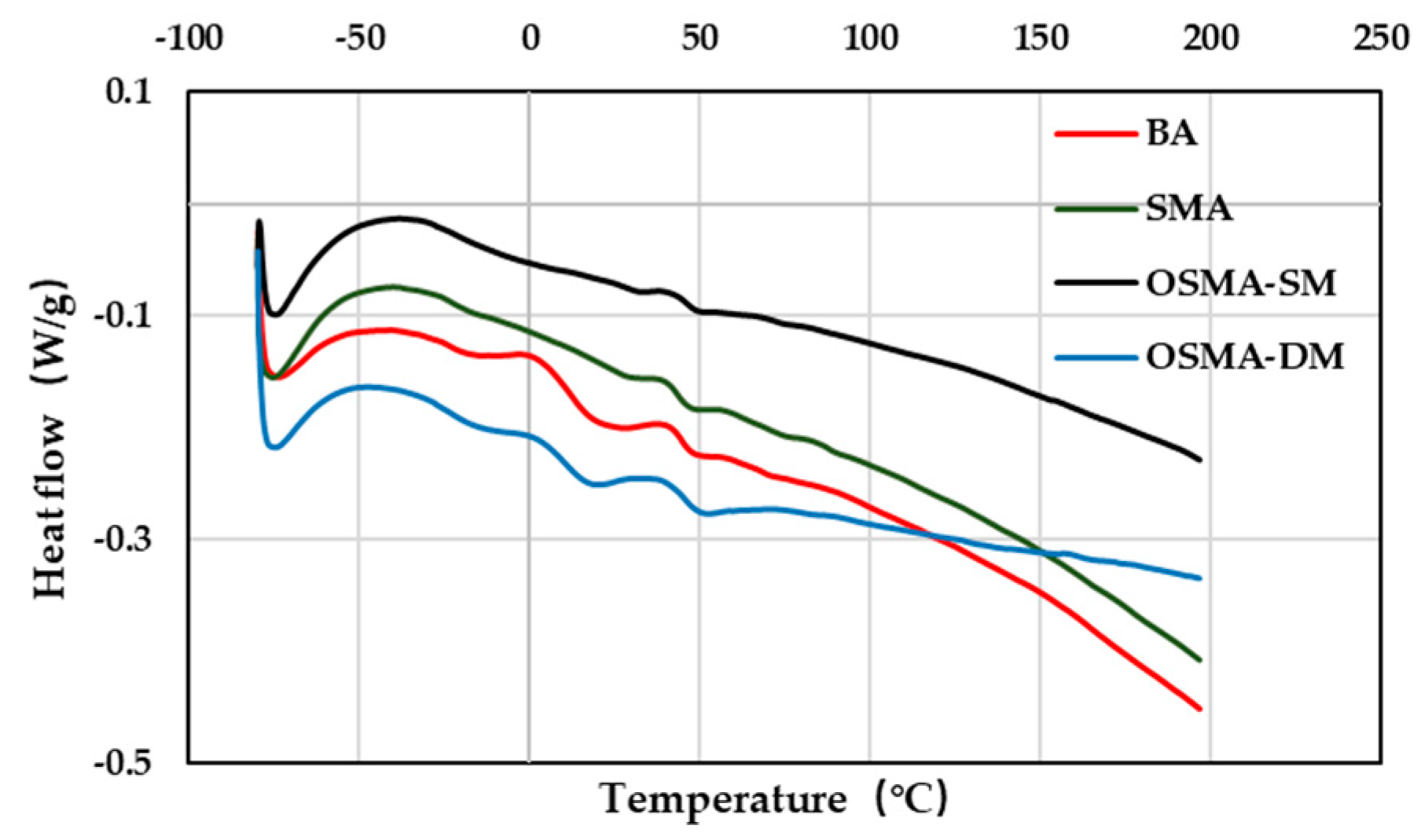1. Introduction
Asphalt has been widely used in airfield and high-grade road pavement due to its numerous advantages such as smoothness, low-vibration, high-automated construction, and easy maintenance [
1,
2,
3,
4]. Worldwide, annually, over 86 million tons of asphalt binder is combined with gravel or sand to pave roads [
5,
6,
7]. However, it has been observed that the production of asphalt requires a major expenditure of natural resources, and the associated mining, refining, production, and construction produce considerable greenhouse gas emissions [
8,
9,
10,
11]. Consequently, the industry has been steadily moving towards adopting more sustainable practices [
12,
13,
14].
The main objective of sustainable development is to use natural resources in the most optimized way so that, environmental and socioeconomic issues are minimized [
15,
16,
17]. In the past few years, studies regarding alternative environmental friendly materials in asphalt pavement to improve its mechanical properties have been conducted [
18,
19,
20,
21]. The use of industrial waste is a promising solution to minimize environmental pollution by sinking the accumulation of waste materials, which results in a reduction of the construction costs [
22,
23]. Tarbay et al. presents the use of waste materials (marble and granite) and byproduct material (steel slag) as alternative to the mineral conventional filler. The test results show that all materials enhanced rutting resistance compared to the traditional limestone filler [
24]. Abo El-Naga et al. investigated the effect of using polyethylene terephthalate waste plastic materials (PTP) on improving the performance and properties of asphalt pavement. The conclusion indicated that addition of 12% of PTP increased the pavement service life 2.81 times and saved ~20% of the asphalt layer thickness [
25]. Saberian et al. assessed the effect of crushed glass on the behavior of the crushed recycled materials together with crumb rubber for road pavement applications. The results indicated that the blends of waste materials, as a low-carbon concept, could be a viable and satisfactory alternative solution for future base/subbase applications [
26].
Oil shale, a sedimentary rock containing organic matter, belongs to high-mineral sapropelite, a low-calorific solid fossil fuel with a light-gray to dark-brown color [
27,
28]. Oil shale has more than 40% ash, which is the main difference from coal. The inorganic mineral content of oil shale is approximately 50–80%, mainly including quartz, potassium feldspar, plagioclase, kaolin, clay, mica, carbonate, pyrite, etc. The oil shale resources in the world are very rich [
29]. According to statistics released by the U.S. Energy Information Administration, world shale oil reserves total approximately 11 trillion to 13 trillion tons, far exceeding oil reserves. Global shale oil is generated from Cambrian to Tertiary, mainly in nine countries: United States, Congo, Brazil, Italy, Morocco, Jordan, Australia, China, and Canada. The worldwide distribution of shale oil resources is shown in
Figure 1 [
30].
At present, more than 90% of oil shale is used to generate electricity by combustion and refine shale oil by distillation. With the large-scale exploitation of oil shale, a large amount of waste is produced after combustion or distillation [
31]. However, the majority of oil shale waste is directly piled up in the nearby waste residue field, which causes many environmental problems. Oil shale waste is a polar material that is similar to volcanic rocks and contains traces of organic residual carbon, and has a strong activity. After combustion or distillation of oil shale, the organic matter is instantaneously removed during the rapid heating process to form a porous structure. Since oil shale waste has a porous internal structure, the usage of oil shale waste is very extensive [
32,
33]. Hadi et al. produced low-cost, compressed, strong, lightweight masonry bricks, similarly using the oil shale ash mixed with marble and granite sludge [
34]. Aljbour prepared ceramics specimens from oil shale ash and waste glass by pressing followed by heat treatment [
35]. Wei et al. prepared a long-service-life asphalt mixture by drying and sieving the oil shale waste after combustion to replace the fine aggregate below 4.75 mm as required by the Open-Grade Friction Course (OGFC) [
36]. Wang et al. assessed high- and low-temperature properties of asphalt pavements incorporating dry oil shale waste ash (particle size less than 0.075 mm) as partial filler. The results illustrated that the sustainable asphalt materials have better high-temperature stability and rutting resistance, and also fulfill the requirements of low-temperature cracking resistance [
37].
OGFC is a high permeable mixture used as a surface coat for good friction, and splash-and-spray reduction during rain storms [
38]. However, limitations of the use of such mixtures are greatly affected by the relatively low strength and low stiffness. More specifically, the pavement fails when the asphalt binder ages and becomes brittle. Draindown—a separation of asphalt mastic from the course skeleton—can occur during storage or transport, resulting in a thin binder coating that cannot prevent particles being dislodged by traffic [
39]. The thin binder film can also age more rapidly, aggravating the ravelling problem. Sometimes, this failure occurs when the pavement is only 6–8 years old; such a short life is difficult to accept [
40,
41]. To effectively reduce and prevent the occurrence of ravelling damages in OGFC pavements, technologies adding the modifier are effective for prolonging the OGFC pavement service life [
42,
43]. However, such types of modifiers have high cost, restricting their application in modifying paving asphalt. In the past few years, many studies have been conducted on alternative environmentally friendly materials in OGFC to improve its mechanical properties [
44]. The use of industrial waste is a promising solution to minimize environmental pollution by sinking the accumulation of waste materials, which results in a reduction of the construction costs.
Since oil shale waste is an acidic inorganic material formed by oil shale after distillation or combustion, its compatibility with asphalt is a serious issue in the application of oil shale waste in pavement construction. However, as a new type of coupling agent, silane coupling agents contain two functional groups with different chemical properties: one is a hydrophilic fuctional group, which can be easy to react with inorganic materials, the other is an organophilic functional group, which can be easy to chemically react with an organic polymer material or to form a hydrogen bond, so that the silane coupling agent can effectively improve the compatibility of the organic material and the inorganic material, especially the acidic inorganic material. In this study, the pavement performance and modification mechanism of oil shale waste powder and silane coupling agent composite modified asphalt and asphalt mixture are systematically investigated according to conventional physical property tests: TGA test, FTIR test, DSC test, DSR test, and a pavement performance test. Moreover, the preparation method of the oil shale waste powder and silane coupling agent composite modified asphalt and the surface pretreatment method and direct mixing method are also discussed in this paper.
4. Experimental Procedures
The detailed experimental procedures of this paper are listed in
Table 7. In order to assess the property of asphalt and asphalt mixture systematically, the experimental procedures are divided into two aspects: experimental procedures of asphalt and asphalt mixture. The mechanical properties of ORF/SCA composite modified asphalt, in terms of low-temperature properties, high-temperature properties, temperature susceptibility, and anti-aging properties, were determined by three major index tests (penetration, softening point, and ductility) and the rolling thin film oven test (RTFOT). The effect of ORF and SCA on the behavior and stability properties of asphalt were determined by TGA test (Netzsch Co., Berlin, Germany). The temperature range of the test was from room temperature to 900 °C, and the heating rate was controlled at 20 °C/min. The FTIR and DSC tests were conducted to explore the modification mechanism of OSP/SCA composite modified asphalt. A Vertex 70 Fourier Transform Infrared Spectroscope (Bruker Optics Co., Changchun, China) was employed with wavelength ranging from 40 cm
−1 to 4000 cm
−1. DSC tests were conducted using a DSC-500B (Shanghai yinuo precision instrument co. Ltd., China) to get the thermographs of both neat and modified asphalt binders.
In this section, high- and low-temperature mechanical properties, moisture-sensitive properties, raveling resistance properties, and permeability of OSP/SCA composite modified asphalt mixture were studied respectively. Specifically, the high-temperature mechanical properties of OSP/SCA composite modified asphalt mixture was evaluated by Marshall stability test and wheel tracking test. The low-temperature mechanical properties of OSP/SCA composite modified asphalt mixture was analyzed through the −15 °C splitting test and −10 °C beam-bending test. The moisture-sensitive properties of the asphalt mixture were evaluated by immersion Marshall test and self-designed spring-thawing stability test. To better evaluate the water stability of OGFC in the spring-thawing season, we use the spring-thawing stability index to evaluate the water stability of OGFC in the spring-thawing season. The specimens were treated by vacuum saturation at 97.3 kPa for 15 min and submerged in a container containing water, then the container with specimens were placed in the precision temp-enclosure at −15 °C and frozen 12 h. Then, the specimens were soaked in water at 15 °C for 12 h through controlling the precision temp-enclosure. As described above, a complete freeze–thaw cycle is completed. After 5 freeze–thaw cycles, damaged specimens were collected for Marshall test according to Chinese standards GB/T0709-2011 [
36]. The raveling resistance properties of asphalt mixture was analyzed through standard Cantabro test, and permeability was evaluated by constant head permeability test. In order to ensure the validity and repeatability of the data, the number of parallel tests in each group of experiments was 4–6.
5. Experimental Results and Discussion
5.1. Conventional Physical Property Test Results
The penetration test results of asphalt sample are shown in
Figure 7.
It can be seen from
Figure 7a that the incorporation of modifier reduces the penetration value of asphalt sample. This may due to the swelling and absorption reaction between the asphalt and modifier after the incorporation of modifier and mechanical stirring, which changes the structure of the asphalt colloid and enhances the gelation of the asphalt. The intercept (K) and slope (A) were obtained to calculate penetration index (PI) through linearly regressing the logarithm of penetration (P) against temperature (T). Slope A is defined as a temperature sensitivity coefficient of asphalt.
Figure 7b shows that the temperature sensitivity coefficient of asphalt is, generally, reduced after modification and the temperature sensitivity coefficient of SBS modified asphalt is the smallest. This is due to the fact that SBS, as a polymer, has a large molecular weight and viscoelastic range. The temperature sensitivity coefficient of OSP/SCA composite modified asphalt with direct mixing method is almost the same as SBS modified asphalt, and it also has excellent temperature susceptibility. This may be because OSP as a filler absorb light components with smaller molecular weight in the OSP/SCA composite modified asphalt, so that the distance between the asphalt colloid and colloid formed by OSP is reduced, and the interaction force is increased. Moreover, the bonding interaction of SCA can effectively improve the compatibility of the two components, ensuring OSP and asphalt are mixed to form a stable system. The reason why the temperature susceptibility of OSP/SCA composite modified asphalt with direct mixing method is better than surface pretreatment method may due to the large specific surface area of OSP, which is easier to agglomerate under surface pretreatment method, resulting a negative influence on the dispersion and uniformity of modified asphalt.
The softening point test results of asphalt sample are shown in
Figure 8.
It can be seen from
Figure 8 that the softening point of modified asphalt samples is improved to different degrees compared with that of base asphalt. SBS modified asphalt, OSP/SCA composite modified asphalt with direct mixing method, and OSP/SCA composite modified asphalt with surface pretreatment method are 17.9%, 12.4%, and 9% higher than base asphalt, respectively. This indicates that both the polymer modifier and inorganic modifier can effectively improve the high temperature of asphalt. The main reason is due to the increase in the proportion of high-molecular-weight compounds and the increase of the interaction between the structures. The softening point of the composite modified asphalt is higher than that of the base asphalt partly due to the aging of the asphalt caused by long-term shearing during the preparation process.
The 10 °C ductility test results of asphalt sample are shown in
Figure 9.
It can be seen from
Figure 9 that the SBS modified asphalt has the largest ductility, which is beacuse SBS, as a polymer component, absorbs or adsorbs more asphalt, forming a relatively developed three-dimensional network structure in the asphalt. This three-dimensional network structure restrict the flow and sliding deformation of the asphalt molecules and improves the low temperature performance of the asphalt. Whether using the direct mixing method or surface pretreatment method, the ductility of the OSP/SCA composite modified asphalt is less than the base asphalt. This is because the temperature stress is easily concentrated at the interface of two-component at low temperature, thus the low-temperature of OSP/SCA composite modified asphalt is affected. The 10 °C ductility of OSP/SCA composite modified asphalt with surface pretreatment method is lower than direct mixing method, which is related to the a agglomerate phenomenon of OSP under surface pretreatment method.
The RTFOT aging test results of asphalt sample are shown in
Table 8.
Table 8 shows that the penetration, ductility, and mass of four asphalt samples decreased after the RTFOT aging test. This loss of mass is due to the volatilization of light components after the thermo-oxidative aging of asphalt. The decrease in penetration and ductility indicates that the hardening of asphalt after RTFOT aging test, which is due to the increase of colloid and asphaltene in asphalt. The mass loss rate, 25 °C residual penetration ratio, and 10 °C residual ductility can reflect the anti-aging ability of asphalt; the smaller the mass loss rate, the greater 25 °C residual penetration ratio and 10 °C residual ductility, the better the anti-aging performance. After calculation, it is found that all the asphalt modifiers used in this paper can effectively improve the anti-aging ability of asphalt. Among them, OSMA-DM has the lowest mass loss rate and largest residual penetration ratio and residual ductility compared with the other asphalt samples, which indicates that OSMA-DM has the best anti-aging ability among the four kinds of asphalt. This is because the OSP can absorb more asphalt components to form a poly group, and the formed poly group has a thick colloidal interface layer; the long-range interaction between molecules is wide, thereby the formed structure is relatively stable. Meanwhile, the bonding interaction of SCA ensures that the adsorbed asphalt component does not precipitate from the poly group, thereby effectively enhancing the stability of the asphalt and improving the anti-aging property of the asphalt. The reason why the anti-aging property of SMA is worse than that of OSMA-DM is that SBS is a high molecular polymer. The substructure of the polymer is prone to change after thermal oxidation process, while OSP is an inorganic material that is not susceptible to thermal oxidation process.
5.2. Thermogravimetric Analysis Test Results
TGA was employed to evaluate the thermal properties of the OSP/SCA composite modified asphalt.
Figure 10 presents the thermogravimetric curves of the four asphalt samples. As observed, TGA thermographs relate to particular phases of degradation with distinct initial and final degradation temperatures, and the addition of modifiers changes the distinct initial and final degradation temperatures, which is the result of pyrolysis of the specimen. The TGA of SMA is significantly different from other three kinds of asphalt, especially in the range of 400 to 500 °C, the weight loss of SMA is faster. This may be due to the rapid cracking and volatilization of the high molecular polymer modifier between the temperature range.
From TGA curves of all the asphalt samples, the following parameters were calculated for further comprehension of the thermal properties of OSP/SCA composite modified asphalt. (1) Start of thermal degradation (temperature at 90% weight loss) (Ts, °C), (2) peak temperature (temperature at 50% weight loss) (Tp, °C), and (3) residual mass (Me, %).
Table 9 present a summary of the TGA test parameters of asphalt samples.
As shown in
Table 9, the Ts values of BA, SMA, and OSMA-DM are approximate, but the Ts value of OSMA-SP is lower than that of the other three kinds of asphalt, which indicates that the OSP with surface pretreatment of SCA is poorly dispersed in the asphalt. The Tp value of OSMA-DM was increased by 4.7 °C compared with BA, and the Me value of OSMA-DM was increased by 24% compared with BA, indicating that the high temperature stability of the asphalt is improved under the composite modification of OSP and SCA and the high temperature cracking of the asphalt is effectively suppressed. OSMA-DM has obvious improvement in Ts, Tp, and Me compared with SMA and OSMA-SP, thus indicating OSMA-DM with better thermal property, and OSP has higher dispersibility and thermal stability in OSP/SCA composite modified asphalt.
5.3. Fourier Transform Infrared Spectroscopy Test Results
Bitumen is a mixture of substances with different molecular sizes, chemical compositions, and structures. The properties of modified asphalt are determined by the nature of asphalt and modifier and the interaction between the two. At present, the modification mechanism between modifier and asphalt is generally divided into physical blending modification and chemical blending modification. The physical blending modification means that the modifier is swelled and dissolved by the action of aromatic hydrocarbons and saturated hydrocarbon, and uniformly dispersed in the asphalt to form a blend system during the preparation process. Furthermore, there is no chemical reaction and the formation of related chemical bonds during the preparation process. The chemical blending modification refers to a chemical reaction between modifier and bitumen, which produces chemical cross-linking, chemical addition, or chemical bonds. The Fourier transform infrared spectroscopy test was employed to explore the modification mechanism of OSP/SCA composite modified asphalt. For the comprehension of FTIR spectra, the whole range is generally divided into two regions of 4000–1300 cm
−1 and 1300–600 cm
−1. The peak emerged at 4000–1300 cm
−1 is an absorption band generated by stretching vibration. Since the characteristic absorption peak of the group is usually located in this high frequency region, and the absorption peak is parsley distributed in this region, this region is the most valuable region for identifying the functional group, which is called the functional group region. In the region of 1300 to 600 cm
−1, in addition to the stretching vibration of single bond, there are complex spectra generated by deformation vibration. When the molecular structure is slightly different, there is a slight difference in the absorption peaks in this region. This phenomenon is like that each person has a different fingerprint, so this region is named the fingerprint region. Analysis of FTIR spectra generally requires searching for the characteristic stretching vibration of the functional group in the functional group region, and further confirming the existence of the functional group and the combination with other functional group according to the absorption peaks in the fingerprint region. The correspondence between representative chemical bonds of asphalt and FTIR spectra peak position is shown in
Table 10 [
46].
From the FTIR spectrum of BA, it can be seen that the strong absorption peaks at 2918 cm−1 and 2851 cm−1 are the asymmetric and symmetric stretching vibration absorption bands of C–H in aliphatics (mainly alkanes and naphthenes), respectively, and the peak at 1600 cm−1 is the C–C stretching vibration in aromatics. The peaks at 1458 cm−1 and 1375 cm−1 are the in-plane bending vibration absorption peaks of C–H in aliphatics, the peak at 1032 cm−1 is the sulfoxide group (S=O) stretching vibration, and the four small absorption peaks in the range of 863 to 724 cm−1 are the out-of-plane bending vibrations of C–H on aromatic benzene rings. Thus, asphalt is mainly composed of saturated hydrocarbons, aromatics, aliphatics and heteroatom derivatives.
The FTIR spectra of SMA is similar to that of BA, it has a strong absorption peak around 2800–3000 cm−1 and the peak position is also basically the same as that of BA. In the functional group region, It can be seen from FTIR spectra of SMA that a absorption peak emerged at 2360.67 cm−1, which may be due to the infiltration of carbon dioxide during the preparation of SMA. In the fingerprint region, two peaks emerged at 744.47 cm−1 and 1029.91 cm−1. The peak at 1029.91 cm−1 is the blending vibration of C–H in RCH=CH2, indicating the RCH=CH2 structure in both styrene and butadiene of SBS. Peak at 744.47 cm−1 is the blending vibration of aromatic branches. It can be seen that the incorporation of SBS does not change the chemical structure unit of itself and the asphalt, the modification mechanism of SMA is mainly physical blending modification.
The FTIR spectra of OSMA-SP and OSMA-DM are approximately the same. Strong absorption peaks emerged around 2800–3000 cm−1 are the C–H vibration of cycloalkane and alkane. Among them, the absorption peak of -CH2- is the strongest, and the peaks at 2921 cm−1 and 2851 cm−1 are stretching vibration of -CH2-. Different from the base asphalt, OSMA-SP and OSMA-DM have a strong absorption peak at 3675.41 cm−1 in the functional group region, and the peak represents an O–H vibration of the carboxyl group. This indicates that there is a new chemical bond formation in the OSMA-SP and OSMA-DM due to the graft reaction of SCA with OSP. In the fingerprint region, it was found that a new absorption peak was emerged at 1056.35 cm−1 in the FTIR spectra of OSMA-SP and OSMA-DM. The peak is vibration of sulfoxide group (S=O), and sulfoxide group is generally considered to be an important indicator to evaluate the aging of asphalt, which indicates that there is some thermo-oxidative aging caused by long-term shearing has occurred during the modification process of OSMA-SP and OSMA-DM..
The chemical reaction of the modifier with asphalt causes the appearance of new functional groups and the change of peak height and peak area of absorption peak. In order to quantitatively analyze the modification mechanism of three modified asphalt samples, the peak height and peak area of main functional groups of the four asphalts were statistically analyzed through ORIGIN software, as shown in
Table 11 and
Table 12.
It can be seen from
Table 11 and
Table 12 that the peak area and peak height of OSMA-DM are much larger than OSMA-SP at 3675.4 cm
−1, which indicates that more chemical bonds are generated in the OSMA-DM and SCA reacts more adequately with OSP. This conclusion is also consistent with the results of conventional physical property test. The peak height and peak area of SMA, OSMA-SP and OSMA-DM at 2360.7 cm
−1 are much higher than that of BA. Due to the consistency of the experimental environment, only the infiltration of carbon dioxide during the preparation of modified asphalt can explain this phenomenon. The peak area and peak height of SMA and BA are slightly different at 2852 cm
−1 and 1456.2 cm
−1, but the difference is not large, which indicates that the modification mechanism of SMA is mainly based on physical blending modification, but there is also certain chemical blending modification.
5.4. Differential Scanning Calorimetry Test Results
The thermal effect of asphalt during temperature change can be measured by DSC. The microscopic changes of the regate structure in asphalt can be characterized through the endothermic peak position and heat absorption of the DSC spectrum; thus, the temperature stability of asphalt can be evaluated and the modification mechanism can be speculated. The DSC spectrum of four asphalt samples are shown in
Figure 15.
As can be seen from
Figure 15, the DSC spectra of the four asphalt samples are equivalent, but there are differences in some endothermic peak positions and heat absorption. The DSC curve of OSMA-DM is flatter than the other three types of asphalt, and the endothermic peak is relatively small. This indicates that the thermal stability of OSMA-DM is better than that of the other three types of asphalt, which is consistent with the conclusions of TGA test. As the temperature changes, the asphalt has three states—glassy state, viscoelastic state, and viscous flow state—and the change of state is caused by the change of regate structure with temperature. When the temperature is above 80 °C, The DSC curve of modified and unmodified asphalt has almost no endothermic peak, which indicates that most components of asphalt have completed the transition from the viscoelastic state to the viscous state at 80 °C. The DSC spectrum also indicates that the asphalt is in an endothermic or exothermic instability stage at 15 °C, 25 °C, and 30 °C, which is also the evolution process of regate structure, thus the penetration test is greatly affected with temperature under this temperature range.
The phase of asphalt changes with increasing temperature and it appears as a peak on the DSC curve. Two main parameters can be obtained on the DSC curve, one is the heat absorption during regate structure transformation, and the other is the temperature range at which regate structure transformation occurs. The endothermic peak data of modified and unmodified asphalt are summarized in
Table 13.
The heat absorption reflects the amount of transformed regate structure and the ratio of solid and liquid composition in the asphalt. The smaller the heat absorption, the smaller the amount of solid–liquid conversion in the asphalt and more stable the properties.
Table 13 shows that the total heat absorption of modified asphalt is reduced compared with base asphalt, which indicates that the modification process is not only a process of physical blending of two materials, but also an improvement and reinforcement of the properties of the asphalt. SCA and OSP change the large endothermic peak of base asphalt to a small endothermic peak; the DSC curve becomes relatively flat and the peak width becomes relatively narrow. This illustrates that the form and quantity of crystalline component and the transformation of components in the bitumen are changed through the incorporation of OSP and SCA. Meanwhile, the melting temperature of some components is changed, and the temperature stability and temperature susceptibility of asphalt is improved.
5.5. Pavement Performance Test Results
The pavement performance test results are shown in
Table 14.
Table 14 shows that the high-temperature properties of the asphalt mixture are improved after the incorporation of modifier. The specification requires that the Marshall stability of OGFC should be greater than 5 KN and dynamic stability be greater than 3000 n/mm; all three asphalt mixtures meet the specifications. The Marshall stability and dynamic stability of ORF/SCA-OGFC increased by 12.2% and 16.6%, respectively, compared to OGFC, demonstrating that OSP/SCA composite modified asphalt can effectively improve the high-temperature performance of OGFC. OGFC is a skeleton structure with a large porosity. In high temperature environments, once the asphalt mortar does not provide sufficient constraints and restrictions on the skeletal structure, it will cause permanent deformation of pavement. As a kind of high viscosity modified asphalt, SBS modified asphalt can effectively increase the adhesion between asphalt and aggregate, effectively limit the relative movement between aggregates, thus, SMA-OGFC has obvious improvement in high temperature mechanical properties, especially rutting resistance. The enhancement mechanism of of high-temperature mechanical properties of SMA-OGFC and ORF/SCA-OGFC is different. The main difference is that there is a certain chemical adsorption between OSP/SCA composite modified asphalt and aggregate. The SCA in OSP/SCA composite modified asphalt has a silicon functional group and an organic group, and the silicon functional group can react with the hydroxyl group on the surface of aggregate to form a chemical bond; the organic group can react with asphalt to achieve chemical bonding, thereby the two materials of very different properties of asphalt and aggregate are “coupled” by chemical bonds, and the chemical bonding reaction is confirmed by FTIR test in the
Section 5.3.
It can be seen from the −15 °C splitting test and −10 °C beam-bending test that the splitting strength and bending tensile strength of ORF/SCA-OGFC increased by 18.2% and 13.8%, respectively, compared with OGFC. This illustrates that ORF/SCA composite modified asphalt can effectively improve the low-temperature mechanical properties of OGFC. The improvement of low-temperature mechanical properties of SMA-OGFC is greater than that of ORF/SCA-OGFC. This is because OSP is an inorganic material, which is very different from the low temperature modulus of asphalt. At low temperature, the stress is prone to generate at the interface of two-phase (OSP-asphalt) to form a shear band, which results in a relatively small improvement in low-temperature mechanical properties of ORF/SCA-OGFC.
The immersion Marshall test, spring-thawing stability test, and Cantabro Test results reveal that ORF/SCA composite modified asphalt can effectively improve the moisture damage and raveling resistance of OGFC. The immersion Marshall stability and spring-thawing stability of ORF/SCA-OGFC was 4.7% and 12.2% higher than OGFC, respectively; Cantabro losses of ORE/SCA-OGFC is 5.3% smaller than OGFC. The greater Cantabro losses indicates that the worse raveling resistance. The main reason for this is that the OSP has a special microscopic structure such as porous and large specific surface. The OSP can absorb the light weight component with less molecular weight in the asphalt, and form a series of complex interactions with asphalt, such as dispersion, superfolding, embedding, and cross-linking, which enhances the aggregate–bitumen interface bond strength and improve the mechanical structure of OGFC. Moreover, the bonding reaction of SCA at aggregate–bitumen interface is also a reason for reinforcement of mechanical properties. The permeability coefficients of OGFC, SMA-OGFC, and ORF/SCA-OGFC are 0.19 cm/s, 0.28 cm/s, and 0.22 cm/s, according to the constant head permeability test. It is well known that asphalt–aggregate ratio plays a key role in permeability performance of OGFC when the gradation is consistent. The lower the asphalt–aggregate ratio, the better the permeability performance. The permeability test results of three asphalt mixtures also confirmed this regular pattern.
In conclusion, the ORF/SCA composite modified asphalt can effectively improve the overall performance of the OGFC, although the improvement is not as good as the SBS modified asphalt, but the ORF/SCA composite modified asphalt has a strong advantage in reducing the construction cost, protecting the environment, and recycling solid waste.
5.6. Economic and Environmental Analysis
In this section, the economic and environmental analysis of SMA-OGFC and ORF/SCA-OGFC mixture in improving properties is conducted compared normal OGFC mixture. The price ratio
PR and performance improvement ration
PIR can be calculated by the following equation. The results are listed in
Table 15.
where
Pm and
PIm are the price and properties of SBS-OGFC and SM-OGFC, respecitvely, and POGFC and PIOGFC are the price and properties of the normal OGFC mixture [
47].
It should be noted that when referring to the marked price in China, the prices of unmodified asphalt binder, SBS and silane coupling agent are 4 CNY/kg, 15 CNY/kg and 6 CNY/kg, respectively. The average price of OGFC-16 unmodified asphalt mixture is 0.380 CNY/kg. It can be calculated that the price of graded broken stone of OGFC-16 is 0.1975 CNY/kg. At present, oil shale waste is generally deposited on open space due to no post-procedure of oil shale waste in China, so the environmental protection costs by waste accumulation cannot be accurately calculated. Therefore, the resettlement fee for construction waste is defined as the environmental protection costs of oil shale waste, and the price is ~10 CNY/kg. Since in the three asphalt mixtures only ORF/SCA-OGFC can consume oil shale waste, the environmental protection costs should be deducted for the mixture price of ORF/SCA-OGFC, and the environmental protection costs for 100 kg ORF/SCA-OGFC asphalt mixture is 2.76 CNY.
As shown in
Table 15, the ORF/SCA composite modified asphalt improved the overall performance of the OGFC by ~10% compared with normal OGFC. Although there is a certain gap between the increase of OFR/SCA-OGFC and SBS-OGFC, the price of ORF-OGFC is lower than that of SMA-OGFC, and OFR/SCA-OGFC played an important role in reducing the cost compared with high-priced modified asphalt, especially in protecting the environment and enriching the utilization ways of oil shale waste
